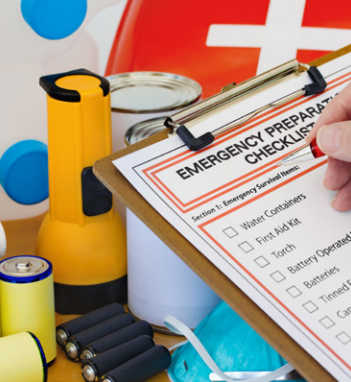Emergency Planning Design
by Laura George
The most important thing that a person can do for an impending disaster is to become informed on how they will live, survive and move forward after the event. When discussing Emergency Preparedness, it is best to consider it Emergency Planning Design because the topic includes planning before, during and after the disaster. Furthermore, a plan must be designed to ensure that you can live at least three to seven days after a disaster with no support.
Remember “YO-YO” (You are On Your Own) in a disaster! Creating your emergency design plan may seem overwhelming. However, working on it step by step ensures its current relevancy to your life and will ensure your safety through a disaster.

For people with disabilities, preparation doesn’t just include water, food and batteries. It also includes access to medications, tools/technologies, caregivers/provider agencies, spare medical supplies/hardware, transportation and safe, accessible refuge to maintain independent living. Look to your state’s resources on emergency planning. Then, look to your county of residence for local resource agencies, websites, social media platforms and other disability advocacy organizations or support groups.
After completing your research, decide on three locations for safe refuge:
- One for staying in place.
- One for leaving your residence.
- One for if the first two fall through or are not an option.
Your prepared “Go Kit” should have the above-mentioned basics along with items that everyone in your household, including any service animals and pets, would need. A weather radio, manual can opener, First Aid kit, local maps, flashlights and batteries are also helpful. Equally important is a document in your kit that lists important contacts and your medical health information (e.g., details such as if you have any implanted devices, the need for an interpreter for communication with others and dietary concerns).
Now, congratulate yourself because you have completed most of your Emergency Planning Design! However, after researching your local community’s resources, you’ve likely found some unanswered questions. Find your voice! You are 100% responsible for your personal plan until you have questions. Then your community shares responsibility to help you find the answers.
Contact your local police, fire, health department and emergency management agencies for the additional solutions you need. Ask about their emergency planning committees. Remember, you are not the only one with a unique concern. First responders are genuinely interested in learning about people with disabilities and how to work us into their emergency plan for the community. Consider volunteering on Emergency Preparedness committees and other organizations.
Be alert! Be prepared! Be safe!
Georgia Emergency Preparedness Resources:
- Ready Georgia
- Georgia Emergency Management and Homeland Security Agency (GEMA)
- Georgia Department of Public Health
Disability Specific Resources:
- Georgia Emergency Preparedness Coalition for Individuals with Disabilities and Older Adults
- Independent Living Centers
- Partnership for Inclusive Disaster Strategies
- Smart Response
- Pass It On Center
- Americans with Disabilities Act
- The Right To Be Rescued: Disability Justice in an Age of Disaster
- What to pack for people with disabilities in emergencies
- Searchable database of videos with multiple language captions and ASL
Volunteering Opportunities:
Laura George sits on the Emergency Preparedness Committee for the National Council on Independent Living and is the Program Director of Emergency Preparedness for Access and Functional Needs at Noah’s Ark and Company, Inc. She is also an author, presenter and caregiver.
To read the entire magazine, see below:


